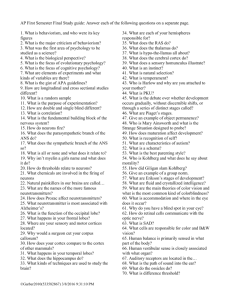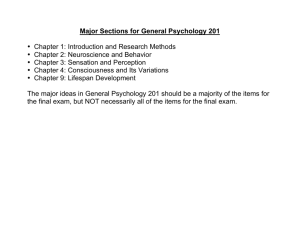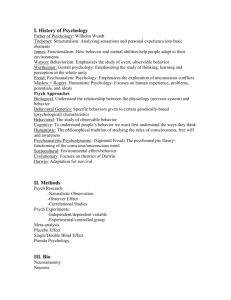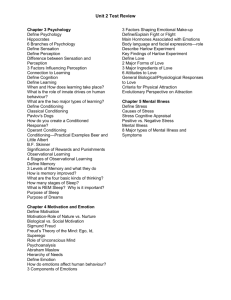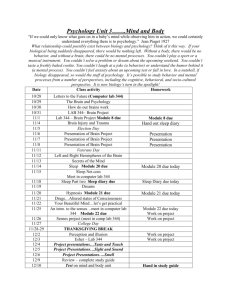Test 1 Study Guide - Gordon State College
advertisement
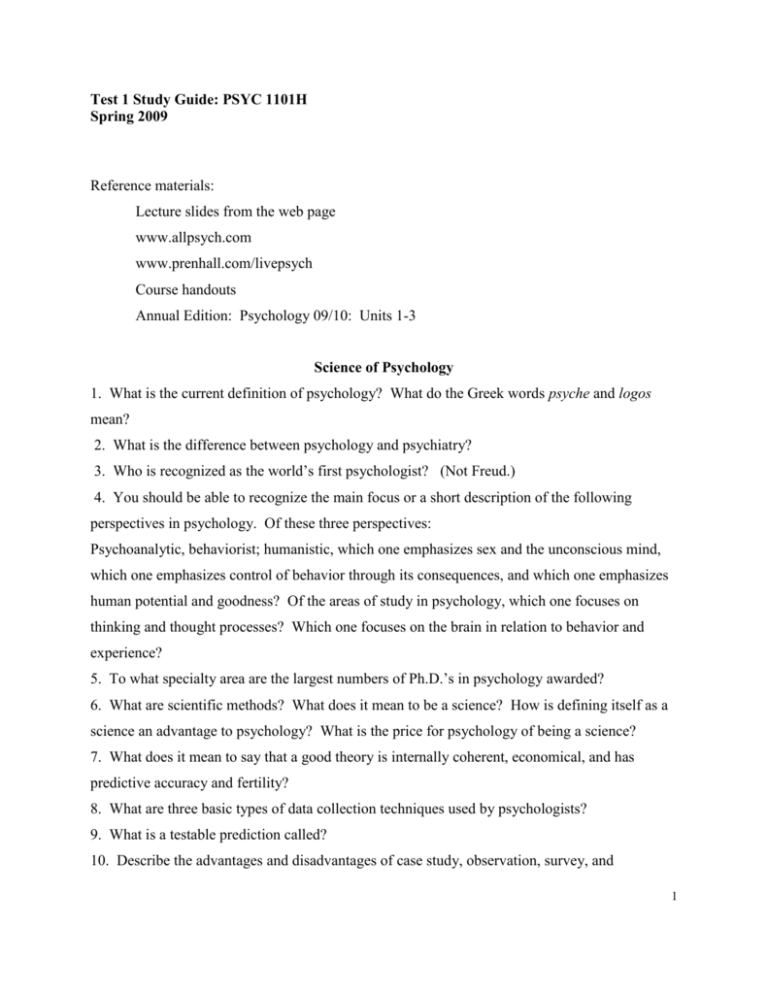
Test 1 Study Guide: PSYC 1101H Spring 2009 Reference materials: Lecture slides from the web page www.allpsych.com www.prenhall.com/livepsych Course handouts Annual Edition: Psychology 09/10: Units 1-3 Science of Psychology 1. What is the current definition of psychology? What do the Greek words psyche and logos mean? 2. What is the difference between psychology and psychiatry? 3. Who is recognized as the world’s first psychologist? (Not Freud.) 4. You should be able to recognize the main focus or a short description of the following perspectives in psychology. Of these three perspectives: Psychoanalytic, behaviorist; humanistic, which one emphasizes sex and the unconscious mind, which one emphasizes control of behavior through its consequences, and which one emphasizes human potential and goodness? Of the areas of study in psychology, which one focuses on thinking and thought processes? Which one focuses on the brain in relation to behavior and experience? 5. To what specialty area are the largest numbers of Ph.D.’s in psychology awarded? 6. What are scientific methods? What does it mean to be a science? How is defining itself as a science an advantage to psychology? What is the price for psychology of being a science? 7. What does it mean to say that a good theory is internally coherent, economical, and has predictive accuracy and fertility? 8. What are three basic types of data collection techniques used by psychologists? 9. What is a testable prediction called? 10. Describe the advantages and disadvantages of case study, observation, survey, and 1 experiments. Which type produces evidence of causality? Why/how is it different from the others? 11. What is a correlation coefficient? What can a correlation show? What can it not show? 12. Why can’t a correlation show causality? 13. What variable represents the assumed cause in an experiment and what does the experimenter do with it? What variable represents the assumed effect and what does the experimenter do with it? (Hint: What is manipulated in the experiment and what is measured?) 14. What is the function of control groups and placebo control groups? Why are participants randomly assigned to groups? ADDED From “Thinking Critically About Sources on the Web” Who can publish information on the Web? Who checks it for accuracy? What is the difference between the information jus “on the Web” and that in full-text databases such as EbscoHost or ProQuest? Name and define five criteria that can be used to judge web site content. How can you check for accuracy? What are some questions that you can ask to help in determining authority? How can you assess objectivity? What is a shortcut to finding highquality Web sites? From “Reading to Understand” How do you know when you understand an article? Are hypotheses or theories in psychology ever proven? Should any measure of central tendency of a data set be called an “average”? What does “random sampling” mean? Define and give an example of each of these: “The bandwagon, extreme statements, glittering generalities, namecalling, and testimonial.” From the summary sheet “Key Concepts for Thinking Critically” You should be able to recognize terms associated with each of the types of evidence. You should know the four steps to thinking critically. You should know how to identify the source. You should know how to tell psychological facts from incomplete research evidence. 2 Biological Bases of Behavior The Neuron 1. What is a neuron? About how many do you have in your body? Describe a neuron using the terms dendrites, cell body, axon, and myelin sheath. What are axon terminals, nodes of Ranvier, glial cells? What are three categories of neurons? How many specific types might there be? What is the top speed of a neuron? Can they regenerate after damage? What is the function of a neuron? 2. What is an action potential (What is conduction?) and what type of energy does it represent? What is the resting potential of a neuron? What is a “threshold” in this context? Is there every any weak or partial firing? Synapses & Neurotransmitters 3. What type of energy do neurons use in communicating with each other? (Chemical – we are ignoring the rare electrical synapse.) What is/are a synapse, synaptic gap, synaptic cleft, and synaptic vesicle? Where are neurotransmitters located? What structures are relevant in the presynaptic (sending) and post-synaptic (receiving) neurons? (There are up to 100 trillion synaptic interconnections in your brain alone.) 4. You should be able to describe what happens at the synapse. What are receptor or binding sites? How is this a "lock & key system?" What is reuptake? What is enzyme deactivation? What happens after the neurotransmitter has returned to the synaptic gap from the receptor site? 5. What are neurotransmitters? About how many different ones have been identified? You should be able to recognize descriptions of these four: Acetylcholine: required for muscle contraction Dopamine: lack of it is a factor in Parkinson’s disease; an excess is related to schizophrenic hallucinations; pleasure centers Serotonin: regulates moods; lack of it is related to depression, Endorphins: are the body’s endogenous morphine and reduce the perception of pain. 6. What is a psychoactive drug? 7. What is common to the way in which all psychoactive drugs act on the nervous system and brain? ) They work by altering the function and effective levels of the neurotransmitters.) What does an agonist do? What does an antagonist do? What is a reuptake inhibitor? 8. Define the following terms: addiction (psychological and physical dependence), tolerance, 3 withdrawal, drug rebound. How is each based on the action of the drugs on the nervous system? 9. You should be able to recognize the drugs and classes of drugs by their long and short term effects, withdrawal symptoms, etc. 1) Depressants - alcohol, barbiturates, tranquilizers 2) Opiates - heroin, morphine, codeine, percodan, demerol, methodone 3) Stimulants - caffeine, nicotine, amphetamines, cocaine, crack, meth-amphetamine 4) Hallucinogens/Psychedelics - mescaline, psilocybin, LSD, PCP, marijuana 10. What is the difference between opiates and depressants? 11. What is a Grand Postsynaptic Potential (GPP) 12. Why are there (what is the function of) gaps (synapses) in the nerves? The Nervous System 1. What does the Central Nervous System consist of? 2. What are the two primary divisions of the peripheral nervous system? 3. What is a nerve? Which part of the nervous system does it belong to? 4. What part of the Central Nervous System controls a simple reflex? The Brain 1. What technologies have been and are being used to study the brain? Briefly, how does each one work, and does it show brain structure or brain activity? – EEG, PET, CT, MRI, fMRI 2. You should be able to associate the parts, structures, or locations on the brain that have been discussed in class and/or included in your textbook with their primary function(s). Brainstem Crossover point, medulla oblongata, pons, cerebellum, reticular formation, thalamus Limbic System . The limbic system overall is associated with emotion. Specifically what structure is associated with rage and fear? Which structure in the limbic system is involved in making new neurons and processing new memories? Which one is associated with the endocrine system and bodily homeostasis? Cerebral Cortex 1. Cortical lateralization means to __________. 2. Name the four lobes of the cerebral cortex. (Remember there are actually eight, because each one is represented on both the right and left hemispheres.) What is the main or primary function 4 associated with each lobe? 3. Why are parts of the body not represented in proportion to their size or mass on the motor and sensory cortexes? What principle seems to be in operation here? 4. What is an association area and what happens there? 5. What is aphasia? What functions happen at Broca’s and Wernicke’s areas? 6. What happens when you sever the corpus callosum? (There might be a question concerning odd behaviors of split-brain patients.) 7. What is a hemispherectomy? Can a person function normally after this procedure? 8. What are the concepts of structural and functional plasticity? 9. How do you maximize your brain's potential? 10. What is the blood-brain barrier, and what does it do? 11. What did we learn from Phineas Gage? Chapter 4: Sensation & Perception 1. What is the difference between sensation and perception? 2. What is the study of psychophysics? What is transduction? 3. What is absolute threshold and how is it defined? What is subliminal perception? 4. How is the difference threshold defined and what is the symbol for it in psychology? 5. What does Weber’s law say? 6. What is sensory adaptation? Why does it normally not occur in vision? 7. How do we experience wavelengths of light? How do we experience amplitude? 8. Why do we have a blind spot? 9. What are the differences between rods and cones; how do they relate to the function of each? 10. You should know what the retina and the fovea are and what each of the three layers of receptor cells/neurons in the retina is named. 11. What are feature detectors? Where are they located? 12. What is parallel processing? What features of vision does the brain parallel process? 13. According to the Helmholz trichromatic theory, how do we see colors? 14. According to Opponent-process theory, how do our brains process color information? (These are complementary and not competing theories.) 15. What are the three primary colors? 16. What is visual capture? What is the sense of hearing called? 5 17. Describe the process of hearing. Which parts of the ear (outer, middle or inner) collect, amplify, and transduce sound? 18. Define the following terms: auditory canal, eardrum, hammer, anvil, stirrup, cochlea, oval window, hair cell, Basilar membrane. 19. How do we experience sound wave amplitude? What scale is used? How do we experience soundwave wavelength or frequency? 20. What is the decibel level of a rock concert and how is it rated in terms of exposure danger for hearing loss? 21. What is your largest and heaviest sense organ? 22. What types of sensations does the sense of touch include? 23. What is gate-control theory? 24. What are the two interactive senses? What is gustation? What is olfaction? What type of stimulus energy do these senses respond to? 25. Where are taste receptors or tastebuds located? How long do they last? Does everyone have about the same number or density of them? 26. What are the four commonly known distinctive tastes? 27. About how many distinct odors can humans detect? 28. Where are olfactory receptors located? To what structure in the brain do they forward information? Does this go through the thalamus? 29. To what mental functions does smell have a mysterious connection? 30. What is kinesthesis and what are the receptors for this sense called? Where are they located? 31. What is the vestibular sense and where are the receptors for this located? Perception 32. What is a gestalt? 33. What is the primary cue that we use to identify an object? 34. What is the principle of figure-ground? 35. Describe each of the five perceptual grouping principles. 36. Describe the two binocular cues for depth perception. 37. Describe five monocular cues for depth perception. 38. What is the size-distance relationship? 6 39. What is the Muller-Lyer illusion? How does it depend upon the size-distance relationship according to the carpentered-world hypothesis? 40. What is perceptual set? 41. What is extra-sensory perception (ESP)? What are telepathy, precognition, psycho kinesis, clairvoyance (remote viewing)? 42. What is parapsychology? 43. What types of research have been done? 44. What explanations does psychology offer for paranormal phenomena? Answer: Psychology does Not endorse as a natural human ability. Consider the possibility of trickery. Consider the possibility of misperception, imagination, or intuition. Psychology cannot speculate about the supernatural. 45. Why do psychologists refuse to endorse ESP as a natural, although unusual human ability? OMIT FOR NOW: THERE WILL BE NO QUESTIONS ON SLEEP & DREAMS. Consciousness Sleep & Dreams 1. What is consciousness? 2. Describe the sleep cycle. How long is it? How many stages does it have? What are delta waves and which sleep stage do they dominate? 3. What is the difference between REM and NREM sleep? 4. How often do people probably dream? 5. Do we know why we sleep? What happens to us if we do not sleep? What are some of the symptoms of sleep deprivation? What happens to us if we are deprived of REM sleep? How long can lab rats live without sleep? 6. What is a sleep disorder? What is a parasomnia? 10. You should be able to recognize descriptions of the following, including the stage of sleep in which they occur (REM vs. NREM): insomnia, sleepwalking, night terrors, REM sleep behavior disorder, sleep apnea, and narcolepsy. Why is REM sleep called paradoxical sleep? What is REM rebound? 7 11. What are the characteristics of dreams? Why do we not remember our dreams? What do we dream about? (Most often, we dream about activities of the previous day.) What are the theories of why we dream? Annual Edition: Psychology 09/10: Units 1-3 Article 2: How has psychology affected animal training? Treatment of mental illness? Testing? Parenting, prejudice, political polling? Treatment of premature infants? Article 3: What is the difference between a skeptic and a cynic? What is the difference between pseudoscientific, merely false claims, and metaphysical claims? What is the difference between methodological and philosophical skepticism? Article 4: What is the complaint of scientific researchers found in this article? Article 5: Define phantom limb (also found in Article 7), synesthesia, and achromotopia. Article 8: According to this article, what are some possible effects of testosterone and estrogen on the brain? Article 9: How are OBE’s and NDE’s best defined? Why has science had trouble with these? Is it possible to gather research evidence on these? Why did Moody’s and Tart’s popular press books get in the way of scientific Acceptance? According to a 1990 Gallup poll, what percentage of Americans have had NDE’s? What are some common elements of their experiences? What is a fascinoma? What did early explanations of OBE/NDE attribute the delusion/hallucination to? What did both Moore and Lommel find to be the only factor that distinguished between patients who did and did not have NDE’s? What did Whinnery find in his G-LOC studies? What are apparently the long-term consequences of having an NDE? What did Britton mean by “an atypical response to a life-threatening situation?” 8 According to studies of Buddhist monks and Franciscan nuns, what brain pattern is associated with spiritual experience? What are some ways to facilitate or achieve this? How does having had an NDE seem to affect REM sleep? 9


